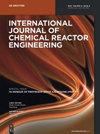Ferrous and manganese oxalate for efficient heterogenous-Fenton degradation of organic pollutants: composite active site and mechanism perception
IF 1.6
4区 工程技术
Q3 Chemical Engineering
International Journal of Chemical Reactor Engineering
Pub Date : 2023-05-23
DOI:10.1515/ijcre-2023-0024
引用次数: 0
Abstract
Abstract Composite heterogeneous catalysts of ferrous and manganese oxalate (FeC2O4/MnC2O4) were prepared via simple chemical co-precipitation. The catalytic performance was evaluated by determining the degradation efficiency of rhodamine B (RhB). Under optimum conditions, 6-1FeMn showed the best catalytic performance, and the degradation efficiency exceeded 95 % within 2 min, which was 1.4 times more than ferrous oxalate. Under a wide pH range (1–8), 6-1FeMn showed high degradation efficiency for RhB with good recyclability and reusability. By characterizing the catalysts before and after the reaction and analyzing the degradation process, a possible mechanism was proposed: Mn2+ and Fe2+ synergistically catalyzed and produced a large number of hydroxyl radicals (·OH) by forming a composite active site for efficient reactivation. Mn3+ accelerated the transfer between Fe2+ and Fe3+. In addition, C2O4 2− reactivated the active site in situ and enhanced the catalytic properties. This study provides new insight into the catalytic degradation of organic dyes using composite heterogeneous Fenton catalysts.亚铁和草酸锰对有机污染物的高效非均相fenton降解:复合活性位点和机制感知
摘要采用简单化学共沉淀法制备了亚铁与草酸锰复合非均相催化剂(FeC2O4/MnC2O4)。通过测定罗丹明B (rhodamine B, RhB)的降解效率来评价其催化性能。在最佳条件下,6-1FeMn表现出最佳的催化性能,在2 min内降解效率超过95 %,是草酸亚铁的1.4倍。在较宽的pH范围(1 ~ 8)下,6-1FeMn对RhB具有较高的降解效率,且具有良好的可回收性和重复使用性。通过对反应前后催化剂的表征和降解过程的分析,提出了一种可能的机理:Mn2+和Fe2+协同催化产生大量羟基自由基(·OH),形成复合活性位点进行高效再活化。Mn3+加速了Fe2+和Fe3+之间的转移。此外,c2o2o2−在原位活化了活性位点,提高了催化性能。本研究为复合非均相Fenton催化剂催化降解有机染料提供了新的思路。
本文章由计算机程序翻译,如有差异,请以英文原文为准。
求助全文
约1分钟内获得全文
求助全文
来源期刊
CiteScore
2.80
自引率
12.50%
发文量
107
审稿时长
3 months
期刊介绍:
The International Journal of Chemical Reactor Engineering covers the broad fields of theoretical and applied reactor engineering. The IJCRE covers topics drawn from the substantial areas of overlap between catalysis, reaction and reactor engineering. The journal is presently edited by Hugo de Lasa and Charles Xu, counting with an impressive list of Editorial Board leading specialists in chemical reactor engineering. Authors include notable international professors and R&D industry leaders.

 求助内容:
求助内容: 应助结果提醒方式:
应助结果提醒方式:


